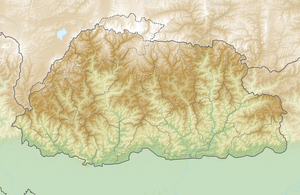Semtokha Dzong
| Semtokha Dzong | ||
|---|---|---|
| Alternative name (s): | San Ngag Sabdon Phodrang | |
| Creation time : | 1629-1632 | |
| Castle type : | Dzong (monastery castle) | |
| Geographical location | 27 ° 26 '17 " N , 89 ° 40' 10" E | |
|
|
||
The Semtokha Dzong , also known as San Ngag Sabdon Phodrang , which means Palace of Profound Tantric Teachings , is a small dzong about 6 km south of Bhutan's capital Thimphu . It was built from 1629 to 1632 by Shabdrung Ngawang Namgyel , the unifier and founder of Bhutan's empire. The Dzong is an important historical monument and a former Buddhist monastery. Until 2011 it housed the Institute of Language and Cultural Studies (ILCS, Institute for Language and Cultural Studies), which is part of the Royal University of Bhutan .
Name derivation
According to popular belief, the dzong offers protection against a demon that has disappeared into a stone near the location of the dzong. The name Semtokha is derived from this, composed of simno (demoness) and do (stone).
location
The dzong is near the intersection of the roads to Thimphu, Paro - Phuentsholing and Punakha - Wangdue . Due to its strategic location on a high mountain ridge, it controls all routes to and from Thimphu.
history
The Semtokha Dzong, built by Shabdrung Ngawang Namgyel from 1629 to 1632, served as a monastic and administrative center and is the oldest dzong that has survived in its original form to this day. With this building, Ngawang Namgyel first introduced the concept of a monastery fortress in Bhutan.
Angered by the new direction of Buddhist teachings under the control of the Shabrdung, five lamas, allied with an army of Tibetans who had invaded the country , attacked the dzong in 1634 . However, the attackers were repulsed by the founder's army. Palden Lama, the leader of the invaders, died in battle.
The first improvement and expansion of the dzong took place in 1671 under the third Desi Minjur Tenpa . In the following years until today, numerous renovations were carried out, the last renovation was carried out by architects from Japan.
In 1961, at the suggestion of Queen Mayum Choying Wangmo Dorje , the third King Jigme Dorje Wangchuk decided to convert the building into a Center for Traditional Studies (ILCS), where students and - since 1989 - female students , were trained to become Dzongkha teachers. In the summer of 2011 the ILC was relocated to its new campus, to Taktse, south of Trongsa in central Bhutan.
Furnishing
Access to the dzong is from the south. The main building of the Dzong is the three-story central tower ( Utse ), which also houses the main temple of the Dzong. At ground level there is a gallery of prayer wheels and slates with portraits of Buddhist saints and scholars on the outer wall of the Utse . The wall paintings of the dzong are among the oldest in Bhutan, they show depictions of the historical Buddha, Shakyamuni , Chenreig , the green and white Tara surrounded by other Bodhisattvas . Another chapel is dedicated to Yeshe Goennpo (Mahakala) and Pelden Lhamo, the protective deities of Bhutan.
literature
- Françoise Pommaret: Bhutan . Edition Earth • Travel Guide. 11th edition. Edition Temmen, Bremen 2013, ISBN 978-3-86108-810-3 , pp. 144 .
- Lindsay Brown, Bradley Mayhew: Lonely Planet Bhutan . Lonely Planet Publications, February 1, 2014, ISBN 978-1-74321-947-8 .
Web links
- Simtokha Dzong. Tourism Council of Bhutan, accessed February 21, 2017 .
- Simtokha Dzong (Sanga Zabdoen Phodrang). Department of Information Technology & Telecom, Bhutan, archived from the original on June 4, 2013 ; accessed on February 21, 2017 .


